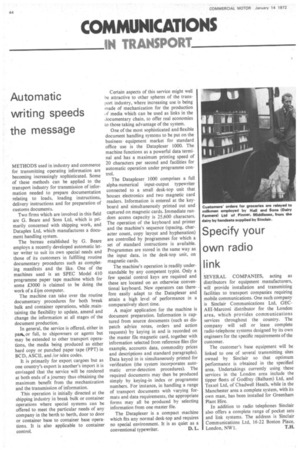Automatic writing speeds the message
Page 46

If you've noticed an error in this article please click here to report it so we can fix it.
METHODS used in industry and commerce for transmitting operating information are becoming increasingly sophisticated. Some of these methods can be applied to the transport industry for transmission of information needed to prepare documentation relating to loads, loading instructions, delivery instructions and for preparation of customs documents.
Two firms which are involved in this field are G. Beare and Sons Ltd, which is primarily concerned with shipping work, and Dataplex Ltd, which manufactures a document handling system.
The bureau established by G. Beare employs a recently developed automatic letter writer to suit its own special needs and those of its customers in fulfilling routine documentary procedures such as completing manifests and the like. One of the machines used is an SPEC Model 410 programme paper tape machine which for some 0000 is claimed to be doing the work of a iim computer.
The machine can take over the routine documentary procedures for both break bulk and container operations, while .maintaining the flexibility to update, amend and change the information at all stages of the document production.
In general, the service is offered, either in patk or full, to shipowners or agents but may be extended to other transport operations, the media being produced as either hard copy or punched paper tape (PPT) in BCD, ASCII, and /or telex codes.
It is primarily for export cargoes but as one country's export is another's import it is envisaged that the service will be rendered at both ends of a journey thus obtaining the maximum benefit from the mechanization and the transmission of information.
This operation is initially directed at the shipping industry in break bulk or container operations where special systems can be offered to meet the particular needs of any company in the berth to berth, door to door or container base to container base operations. It is also applicable to container control.
Certain aspects of this service might well he attractive to other spheres of the transport industry, where increasing use is being made of mechanization for the production of media which can be used as links in the Jocumentary chain, to offer real economies to those taking advantage of the system.
One of the most sophisticated and flexible document handling systems to be put on the business equipment market for standard office use is the Dataplexer 1000. The machine functions as a powerful data terminal and has a maximum printing speed of 20 characters per second and facilities for automatic operation under programme control.
The Dataplexer 1000 comprises a full alpha-numerical input-output typewriter connected to a small desk-top unit that houses electronics and two magnetic card readers. Information is entered at the keyboard and simultaneously printed out and captured on magnetic cards. Immediate random access capacity is 25,600 characters. The operation of the keyboard and printer and the machine's sequence (spacing, character count, copy layout and hyphenation) are controlled by programmes for which a set of standard instructions is available. Programmes are stored in the same way as the input data, in the desk-top unit, on magnetic cards.
The machine's operation is readily understandable by any competent typist. Only a few special control keys are required and these are located on an otherwise conventional keyboard. New operators can therefore easily adapt to the Dataplexer and attain a high level of performance in a comparatively short time.
A major application for the machine is document preparation. Information is captured from source documents (such as dispatch advice notes, orders and action requests) by keying in and is recorded on the master file magnetic card, together with information selected from reference files (for example, accounts data, commodity prices and descriptions and standard paragraphs). Data keyed in is simultaneously printed for verification (the system incorporates automatic error-detection procedures). The required documents may then be produced simply by keying-in index or programme numbers. For instance, in handling a range of transport documents with varying formats and data requirements, the appropriate forms may all be produced by selecting information from one master file.
The Dataplexer is a compact machine which fits any normal desk-top and requires no special environment. It is as quiet as a conventional typewriter. D. L.
















































































































